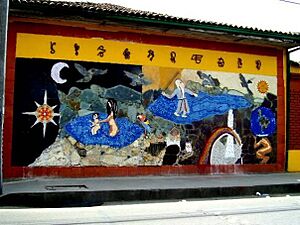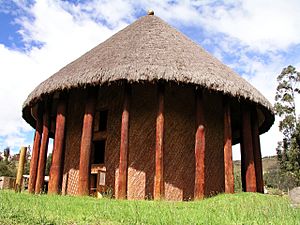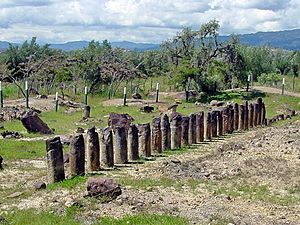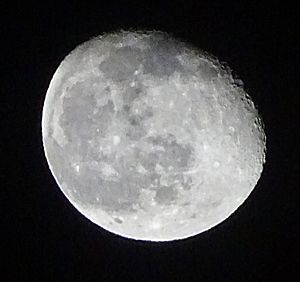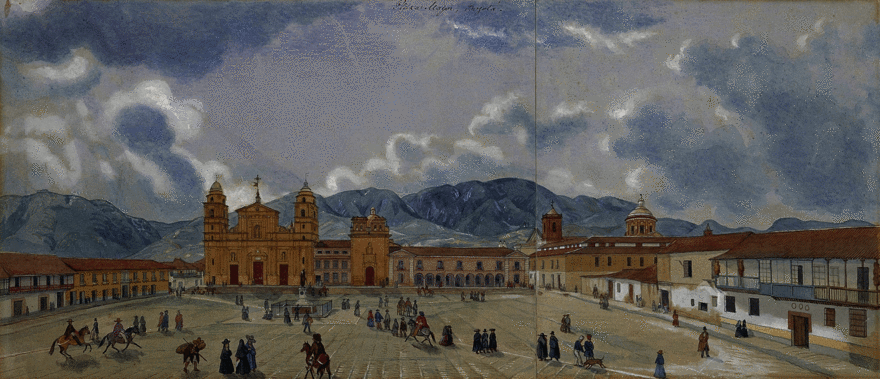Muisca astronomy facts for kids
This article is all about the astronomy of the Muisca people. The Muisca were an amazing ancient civilization in the Americas. They lived in what is now central Colombia. They knew a lot about the stars, Sun, and Moon. This knowledge helped them with their buildings, calendar, and farming.
Many special places where the Muisca studied the sky were built. These were on the Altiplano Cundiboyacense, their homeland in the Colombian Andes mountains. Sadly, many of these sites were destroyed by the Spanish. The Spanish often built their churches on top of them.
One of the best-known sites that still exists is El Infiernito. It's near Villa de Leyva. The Temple of the Sun in the sacred city of Sugamuxi has been rebuilt.
Many smart people have helped us learn about Muisca astronomy. These include José Domingo Duquesne and Alexander von Humboldt long ago. More recently, researchers like Eliécer Silva Celis and Manuel Arturo Izquierdo Peña have added to our knowledge.
Contents
Who Were the Muisca?
The Muisca were a very advanced civilization. They lived on the high plains of the Altiplano Cundiboyacense. This area is now part of Colombia. Their time as a major civilization started around 800 AD. It lasted until the Spanish arrived in 1537.
On these fertile plains, the Muisca had a rich way of life. They were great farmers, using clever ways to drain and water their crops. They also made beautiful things from gold, a mix of gold and copper called tumbaga, and ceramics. They were skilled at making textiles too. Their society had a strong focus on religion and myths.
The Muisca didn't have one big ruler. Instead, they had different leaders who traded with each other. They built special paths called calzadas for trading and religious trips. These paths went across the plains and through the hills.
Muisca Sky Watching
One of the most important Muisca sites for astronomy is El Infiernito. It was named by the Spanish. This site is very old, even older than the Muisca themselves. At El Infiernito, the Sun's shadows line up perfectly with a sacred lake during the solstices. This lake, Lake Iguaque, is where the Muisca believed their mother goddess Bachué was born.
El Infiernito was also a place where Muisca people gathered. They traded goods and held big celebrations. These celebrations likely started during the Early Muisca Period (800-1200 AD). The shadows at El Infiernito also helped predict the rainy seasons.
Astronomy was super important for the Muisca. It helped them know when to plant and harvest crops. It also guided how they built their homes and temples. Their buildings were often built facing east to west. This lined them up with where the Sun, Moon, and Venus rose and set. You can also see symbols of the Sun and Moon in their textiles.
The Muisca used gold for their art and special ceremonies. They thought of gold as "Semen of the Sun." When a new zipa (a Muisca ruler) was chosen, he would cover himself in gold dust. Then he would jump into Lake Guatavita. This event is shown on the famous Muisca raft. During this ritual, music played. Four priests, representing children of the Sun and Moon, surrounded him.
Gods, Myths, and the Sky
The Muisca religion had many gods linked to nature and the sky. For example, Cuchavira was the rainbow god. Chibchacum was the god of rain. Nencatacoa was linked to fertility.
The most powerful Muisca god was Chiminigagua. They believed he created the Universe. He sent two birds to bring light and shape the Earth. His children were Sué, the Sun god, and his wife, Chía, the Moon goddess. These two gods were key to their complex lunisolar calendar. This calendar used different ways to track months based on the Moon's phases and its path around Earth.
Their days were like our modern days. But their years were different. They had "rural years" (12 or 13 months), "common years" (20 months), and "holy years" (37 months).
Bochica was another very important religious figure. He was a bearded messenger god. Myths say Bochica walked from Pasca to Iza. The line connecting these two places points exactly northeast.
Also, the line between the city of Bacatá and the rebuilt Temple of the Sun in Sugamuxi also points northeast. This distance is about 110 kilometers (68 miles). This distance is equal to one degree of the Earth's circumference. If you keep going northeast from there, the line points to the highest peak of the Sierra Nevada del Cocuy mountains.
Muisca Sky-Watching Spots
The Muisca Confederation had many temples and special sites. Very few of them are left today. A rebuilt Sun Temple is in the Archaeology Museum, Sogamoso. The Moon Temple in Chía was destroyed. El Infiernito still exists from before the Muisca.
The Cojines del Zaque are two large stones in Tunja. These stones were lined up with old Muisca temples, like the Goranchacha Temple. The Spanish built their churches on the sites of these old temples. The Cojines stones line up with the Sun's path at certain times of the year. This line goes over the San Francisco church and to the sacred Romiquira hill.
From Bolívar Square in Bogotá, the Sun rises exactly over Monserrate hill during the June solstice. The Muisca called Monserrate quijicha caca, meaning "grandmother's foot." In December, the Sun (Sué) rises behind Guadalupe Hill. They called this quijicha guexica, or "grandfather's foot." During the March and September equinox, the Sun rises right between these two hills.
The Muisca Calendar
| Our year 12 months |
Month 30 days |
Rural year 12/13 mths |
Common year 20 months |
Holy year 37 months |
Symbols and meanings - activities |
|---|---|---|---|---|---|
| 1 | 1 | Ata | Ata | Ata | Jumping toad; "start of the year" |
| 2 | Bosa | Nose and nostrils | |||
| 3 | Mica | Open eyes and nose; "to look for", "to find" | |||
| 4 | Muyhica | Two closed eyes; "black thing", "to grow" | |||
| 5 | Hisca | Two fingers together; "green thing", "to enjoy" | |||
| 6 | Ta | Stick and cord; "sowing" - harvest | |||
| 7 | Cuhupqua | Two ears covered; "deaf person" | |||
| 8 | Suhuza | Tail; "to spread" | |||
| 9 | Aca | Toad with tail connected to other toad; "the goods" | |||
| 10 | Ubchihica | Ear; "shining Moon", "to paint" | |||
| 11 | Ata | ||||
| 12 | Bosa |
The Muisca calendar was very complex. It was based on the Sun (Sué) and Moon (Chía). It used different ways to count months. They had "rural years" (12 or 13 months), "common years" (20 months), and "holy years" (37 months). Their weeks had 4 days, so each month had 7 weeks.
A Muisca "century" was made of 20 holy years. This equals 740 months, which is almost 60 of our Gregorian years. Some researchers found that there might have been slightly different calendars in the north and south of the Muisca lands.


